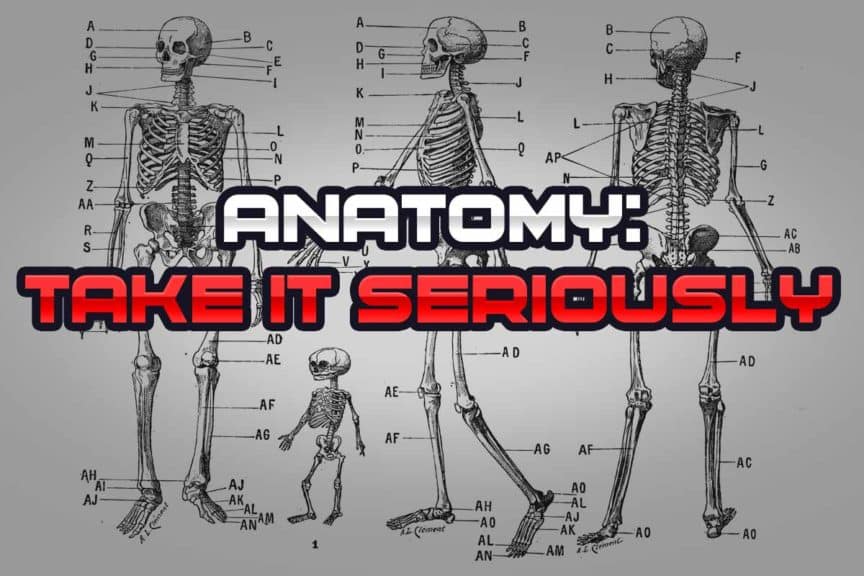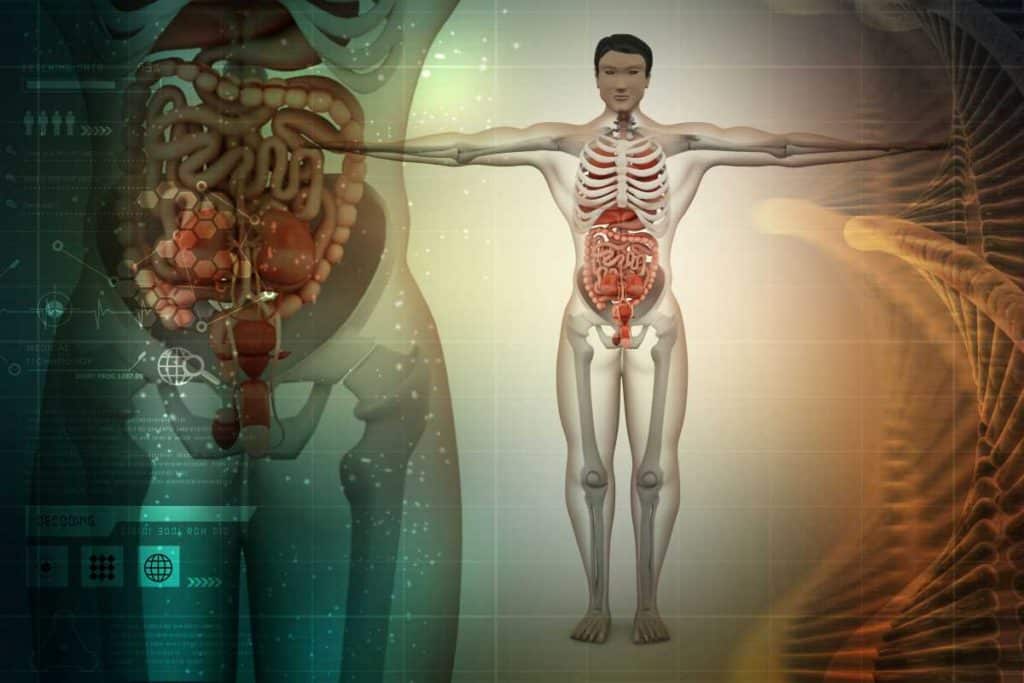If the old saying is true, that the most important factor for building a good house is the foundation you build it upon, then your gross anatomy knowledge is the foundation to your house (your ability to be a successful student while in school and a successful practitioner when in the clinic).
The quick takeaway from this article
No matter where you’re at in your PT journey, there are two main reasons why you should take your anatomical knowledge very seriously:
- As a student, the more you master anatomy, the better you’ll do in your program. The vast majority of your PT curricula stems not just from your direct anatomical knowledge, but your ability to draw upon it and apply it so as to solve more conceptually-based questions and problems.
- As a practitioner, the more you know your anatomy, the better your clinical decision making will be – your palpation skills will be better, your patho-anatomical abilities will be better, and you’ll overall be a much, much better (and thus, successful) clinician.
Why you as a student should take your anatomy knowledge seriously
Trying to get through PT school with sub-par anatomical knowledge is like strapping ankle weights onto your ankles and then trying to swim laps in the pool – you might not necessarily drown, but you’re certainly going to struggle to keep your head above water as you try to progress from one end of the pool to the other.
Also, if you’re a student and are serious about crushing gross anatomy, be sure to check out my article Six Critical Tips to Help You Crush Gross Anatomy and do Better in PT School.
PT school can be a rough, rough ride if you’re not great with your anatomy
The truth is that PT school gets way easier when you have rock-solid anatomy knowledge. This is largely due to two key reasons:
- Many other subsequent courses that you take in PT school will require you to rely on your anatomy knowledge and apply it to various conditions, situations and concepts. In other words, you will need to know your anatomy to more effectively solve the problems presented to you in other courses.
- Doing well in gross anatomy will give you a lot of psychological peace for the rest of your time in PT school. Getting off to a good start in your program can really set the tone and put you in the driver’s seat when it comes to remaining in good academic standing, which is a great feeling.
Key reason one: A high volume of your coursework after you’ve completed gross anatomy will require you to draw upon your anatomical knowledge
Most schools (if not all of them), will give students their gross anatomy course right at the start of their program since the vast majority of subsequent coursework in the program requires you to draw upon your anatomical knowledge. Therefore, the need to complete this course at the start of your program is a necessity.
Subsequent courses such as neuroanatomy, orthopaedics, biomechnics, functional anatomy, therapeutic exercise and so on will often require you to conceptually draw upon your anatomy knowledge in order to effectively answer questions and solve problems posed within each one of those courses. So, if you don’t know your base material when it comes to the human body, you’re likely going to struggle more than you should with material that builds off of it.
I saw it time and time again in my own PT class throughout our program – students who struggled with their anatomy routinely had rather hard times in our orthopaedics courses, biomechanics and neuroanatomy courses. I tutored a lot of them with these courses and it was a very prevalent theme.
Your orthopaedics courses are a great example of this, as orthopaedics is all about musculoskeletal conditions and pathologies that can affect the human body. Learning and conceptually applying this material is highly, highly dependent on how well you know the anatomy that you are expected to know prior to entering these courses. And, it’s largely the same with other courses such as functional anatomy, biomechanics, therapeutic exercise and so on.
Since gross anatomy is the foundation from which the vast majority of your coursework builds upon, you don’t want to build your house of PT knowledge on a sketchy or shaky foundation. It’s worth putting in the extra time throughout your semester of gross anatomy to keep hammering the material into you head, even if you’re sick of it. The semester won’t last forever, and there’s zero consequences to knowing more and more anatomy, be it in school or in clinical practice.
Key reason two: Doing well in gross anatomy will give you a lot of psychological peace for the rest of your time in PT school
A good grade in gross anatomy can help set the tone for the rest of school.
Gross anatomy can essentially “set the tone” for how PT school will go for you. It’s a serious course that is often double the credits as most other courses you’ll take. (Our gross anatomy course was 6 credits while most of our other courses were 3 or 4 credits).
While this course can be extremely fun, it is also very time-consuming and can wreak havoc not only on your overall confidence, but also your academic standing if you don’t take it seriously and give it the respect that it deserves.
Think of it like getting ready for a big title fight in the ring
Imagine stepping into a boxing ring for a big fight, one that is likely to go the full fifteen rounds. Then, imagine that you get absolutely rocked by one or two huge punches in the very first round right away. Likely, not only will this mess with your confidence on being able to get through the entire fight, but it will also make the overall fight incredibly painful and exhausting as well.
This is what it can feel like for students when they get rocked or lit-up right at the start of their program with gross anatomy. I saw it play out with a number of students in my class as well as with the class beneath us. The one’s who struggled heavily in gross anatomy either wound up decelerating in the program a year later or were constantly stressed from walking the razors edge in terms of being close to decelerating or being dismissed from the program.
But imagine that at the start of the boxing match that YOU were the one who gave the heavy punches – you dominate the first few rounds. When you take gross anatomy seriously and thus do well in it (punch it in the face over and over again on each exam), you will gain a great amount of confidence for the remainder of your courses to follow.
Of course, it’s no guarantee that you won’t have any problems with other courses, but the odds are that if you get off to a good start in school and crush one of the most demanding courses right off the bat, you’ll have a great deal of confidence and thus psychological peace for the remainder of the program.
Personally, I’d say that right there is a great reason as to why students should take their gross anatomy seriously.
When it comes to your actual gross anatomy course, becoming exceptionally good as a student might not be easy, but the concept of it is simple
I’ve written an extensive article on Six Critical Tips to Help You Crush Gross Anatomy and Do Better in PT School, which I advise you to read if you want to maximize your chances of success in that monster-of-a-course.
When it comes to your actual gross anatomy course itself, the concept is very simple: Memorize it and be able to regurgitate any of it needed for your exams. Gross anatomy as a course is very different from just about any other course you will take. Pretty much any other course you’ll take will require not just knowing information, but applying it in some sort of way. Not so with gross.
That’s right, with gross anatomy there is no real “application of knowledge” in this course, per se. You don’t need to use formulas or “scientific reasoning”. What you need to do is know anatomical features for just about everything in the body. And be able to identify it for your lab exams and your written exams.
In other words, it’s not easy, but it’s pretty simple: Find some sort of way to lock the knowledge in your head and keep it there. Then, spit it out on your exams. And if you take your time in gross anatomy seriously, you’ll be able to do this and be able to have some major confidence (and much less stress) throughout the rest of your time in PT school.
Why practicing PT’s need to take their anatomical knowledge seriously
My belief is that once we’ve made it through PT school and enter the real world, only then does the “real” learning begin, in that we are now free to learn the areas of PT we want to pursue as our specialty. But, regardless of which area of specialty or designation it may be that we choose, excelling in that area of practice will always be greatly augmented by a superior grasp on anatomical knowledge.
Enhancing our hands-on palpation skills, furthering our understanding or awareness of injuries or pathologies that can affect the human body not learned in PT school are only but a few examples in which we would be wise to continually hone our anatomical knowledge, thus keeping the edge sharp.
PT school was only the beginning for the need to ensure we know our stuff when it comes to anatomy. The new grad/clinician will only be faced with more and more need to ensure their anatomical knowledge is on-point when it comes to treating patients on their caseload more effectively.
The pursuit of excellence within a profession involves a continued effort of ensuring that mastery and subsequent maitenence of foundational knowledge remains a top priority. Advanced knowledge or skill built upon sub-par knowledge in foundational material only serves to rob the clinician of excellence; it robs the clinician in terms of more effectively treating patients in addition to fooling that clinician into believing the most effective treatment has been given; it blinds the clinician from discovering cracks in the foundation that are a liability and detrimental to the overall successful practice of that clinician.
If nothing else, ask yourself: What harm -what danger to my career and my patients – can come from me continuing to work on and improve my anatomical knowledge of the human body?
Closing remarks
Regarding schooling curricula, It’s not to say that all other courses besides anatomy are less important, rather that all other courses are just as important but that most of them rely (to one extent or another) on underlying anatomical knowledge of the human body. As a student, a heavy pursuit towards superior proficiency of anatomy offers an immense “bang for your buck” in terms of what you’ll ultimately get out of that invested study time.
As clinicians, our ability to master anatomical knowledge of the human body greatly assists w/ our understanding of pathoanatomics, orthopaedics, accurate palpations, biomechanics, functional anatomy and on and on and on. It’s certainly not the only skill we as clinicians need to master. Far, far from it. But if there is one skill that serves as the backbone to developing the vast abundance of our other clinical skills, anatomy is the one.
Take anatomy seriously, now and forever more. You’ll thank yourself while in school, and your future self and future patients will be thanking you (and will continue to thank you) as you strive for the pursuit of excellence in clinical practice.

Hi! I’m Jim Wittstrom, PT, DPT, CSCS, Pn1.
I am a physical therapist who is passionate about all things pertaining to strength & conditioning, human movement, injury prevention and rehabilitation. I created StrengthResurgence.com in order to help others become stronger and healthier. I also love helping aspiring students and therapists fulfill their dreams of becoming successful in school and within their clinical PT practice. Thanks for checking out my site!




